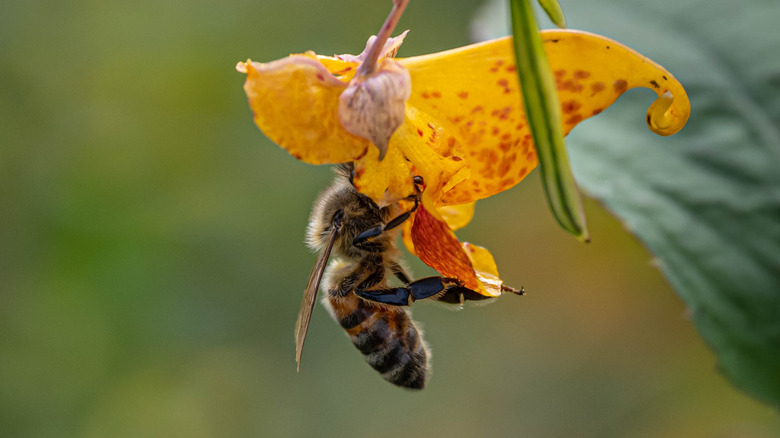Suppress Weeds And Attract Pollinators With This Jewel-Toned Plant
As a member of the balsam family, jewelweed (Impatiens capensis) is related to the colorful impatiens garden centers sell in hanging baskets. Since jewelweed grows up to 5 feet tall, it's seldom planted in hanging baskets. Instead, it likes to form stands. These blankets of wildflowers can outcompete some hard-to-eradicate invasive plants, namely garlic mustard (Alliaria petiolata). This makes jewelweed ideal for weed suppression in many parts of the United States, especially regions where it's a native plant. It's also a lovely addition to rain gardens and plantings designed to draw pollinators.
Impatiens capensis, the most common type of jewelweed, is an annual with striking orange flowers. The flower's hue resembles that of citrine gemstones, and their petals are dappled with red-orange spots. Impatiens pallida, a larger and rarer variety, has pale yellow blossoms. Jewelweed's most common pollinators include hummingbirds, long-tongued bees, and butterflies. One type of bumblebee, Bombus impatiens, loves jewelweed so much that it's named after it. Hummingbirds seek out jewelweed whether it's growing in containers, garden beds, or your lawn. Orange jewelweed is even thought to shape hummingbird migration patterns. These birds head south to find its fiery flowers in the fall. Apparently, the nectar is delicious enough to inspire a long journey.
Jewelweed's elegant flowers beckon human admirers, too. The blossoms hang from the plant's semi-translucent stalks, and their shape is quite sculptural, with curling petals, a purse-like pouch, and a lengthy spur. Shimmering beads of water form on the petals and scalloped green leaves. Fans theorize that these droplets inspired the plant's name.
Things to consider if you want to plant jewelweed
Jewelweed's flowers can make your landscape shine by introducing pops of flame-like color. This plant is a firecracker in another sense, too: Its pods detonate when touched, dispersing seeds in every direction. This has earned jewelweed the nickname of touch-me-not. Want to see the explosion? Nature Lens has captured the drama in a YouTube video. This seed-scattering pop may startle you, but it's not dangerous unless you ingest the pods. It helps the seeds increase their chances of finding ideal growing conditions. When a jewelweed seed finds a damp area with plenty of shade, it's likely to put down roots — and build a large brood that crowds out undesirable weeds.
When cultivating jewelweed, monitor it to make sure it isn't crowding out helpful plants. If orange jewelweed is taking over your lawn or garden, you can control it by pulling it out. The roots are shallow and detach from the soil easily. Avoid planting and remove as much as possible if you live in Washington, where it's considered an invasive species, according to Invasive.org. Planting it in other states is fine. You may also find it growing in ditches, woodland borders, and moist ground near lakes and streams.
Seeking companion plants for jewelweed? Cardinal flower and bloodroot share jewelweed's love of marshy, shady habitats and attract their fair share of pollinators. Jewelweed is also an excellent companion to humans because its sap is a natural remedy for nettle stings, poison ivy rash, and other skin irritations. In fact, this plant has a long history of medicinal use in Native American culture.
